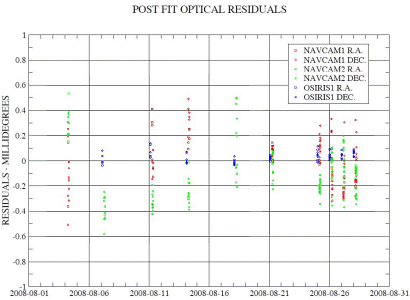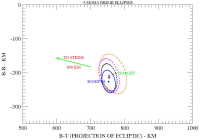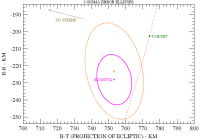No. 103 - Closing in on Asteroid Steins
The slot for trajectory correction on DoY 241 (28 August), eight days before closest approach (CA-8d), was not used. However, the last orbit determination from 28 August confirms that at least one additional trajectory correction manoeuvre (TCM) is required to achieve the desired fly-by conditions. The possible slots for the TCM are on DoY 246, 248, and finally on DoY 249, just 12 hours before closest approach (CA).
The reporting period marked also the start of the scientific activities linked to the fly-by with the characterisation of the light curve of asteroid Steins made by the OSIRIS camera on DoY 233.
Mission operations have been conducted with support of the ESA New Norcia (NNO) and the NASA DSN Madrid ground stations (DSS). In preparation of the fly-by operations proficiency passes with NASA DSN Canberra and ESA Cebreros (CEB) stations have been conducted. During the reporting period there were seven navigation slots for the optical navigation campaign:
| DOY | Date | Pass | Main Activity |
| 229 | 16/08/08 | DSS-65 1632 | Monitoring |
| 230 | 17/08/08 | DSS-54 1633 |
Monitoring |
| 231 | 18/08/08 | NNO 1634 DSS-55 1635 |
Navigation slot 5 Monitoring |
| 232 | 19/08/08 | DSS-65 1636 CEB 1300 |
Monitoring |
| 233 | 20/08/08 | DSS-55 1637 | Asteroid Steins lightcurve |
| 234 | 21/08/08 | NNO 1637 DSS-65 1638 |
Navigation slot 6 Monitoring |
| 235 | 22/08/08 | DSS-54 1639 |
Monitoring |
| 236 | 23/08/08 |
DSS-45 1639 |
Test pass Monitoring |
| 237 | 24/08/08 | DSS-54 1641 | Monitoring |
| 238 | 25/08/08 | NNO 1641 DSS-55 1642 |
Navigation slot 7 Monitoring |
| 239 | 26/08/08 | NNO 1642 DSS-55 1643 |
Navigation slot 8 Monitoring |
| 240 | 27/08/08 | NNO 1643 DSS-55 1644 |
Navigation slot 9 Tracking |
| 241 | 28/08/08 | NNO 1644 DSS-55 1645 |
Navigation slot 10 Monitoring |
| 242 | 29/08/08 | NNO 1645 DSS-55 1646 |
Navigation slot 11 Monitoring |
At the end of the reporting period (DoY 242) Rosetta was at 344.5 million km from Earth (2.3 AU) and the one-way signal travel time was 1149 seconds. The distance to the Sun was 316.4 million km (2.11 AU). Asteroid Steins is at less than 6 million km from Rosetta.
Optical Navigation Campaign
Both the two navigation cameras (NAVCAM A and B, continuously ON since DoY 217) and the narrow angle camera of the OSIRIS instrument are used to take navigation images of asteroid Steins. Since DoY 238 (25 August 2008) the spacecraft is permanently pointing to asteroid Steins and navigation images are taken daily.
The data from these observations are fed into the orbit determination of the Rosetta spacecraft and are used to fine-tune its trajectory towards the asteroid.
The post fit statistics of the data from all the acquired images up to and including 28 August is listed in the table below, separately for the right ascension and declination determination. This includes all the data from the first ten navigation slots (between 4 and 28 August). Stated for the three cameras are: the total number of images obtained on these ten days, the mean residual of the data to the last solution, and both the root mean square and standard deviation of the residuals.
| Optical Navigation post fit statistics (residuals in millidegrees relative to solution) | ||||
|
Right Ascension | ||||
| camera |
No. |
mean | root mean sq. | standard dev. |
| NAVCAM A |
66 |
-0.042 |
0.180 |
0.175 |
| NAVCAM B |
75 |
-0.095 |
0.216 |
0.194 |
| OSIRIS |
40 |
0.030 |
0.050 |
0.040 |
| ALL |
181 |
-0.048 |
0.178 |
0.171 |
|
Declination | ||||
| NAVCAM A |
66 |
0.059 |
0.208 |
0.199 |
| NAVCAM B |
75 |
-0.124 |
0.274 |
0.244 |
| OSIRIS |
40 |
0.038 |
0.053 |
0.037 |
| ALL |
181 |
-0.022 |
0.218 |
0.217 |
 |
|
Figure 1. Post fit residuals of the optical data from the first ten navigation slots (4, 7, 11, 14, 18, 21 August and daily for 25/28 August) for the three cameras (red/green: NAVCAM A/B, blue: OSIRIS) |
The plots below show the situation in the target plane of the 5 September fly-by, with the relative positions of Rosetta and asteroid Steins. The accuracy of the estimated relative fly-by position increases as more data is gathered in the navigation campaign and as Rosetta approaches the asteroid.
Spacecraft
Payload
All instruments are currently OFF with the exception of OSIRIS which is permanently ON and is used to acquire images of asteroid Steins for the navigation campaign.
ALICE
The instrument is OFF.
CONSERT
The instrument is OFF.
COSIMA
The instrument is OFF.
GIADA
The instrument is OFF.
MIDAS
The instrument is OFF.
MIRO
The instrument is OFF.
OSIRIS
The instrument is permanently ON and is used to acquire images of asteroid Steins and the background stars. As from DoY 238 navigation images are taken daily. On DoY 233 OSIRIS performed the first science activity linked to the asteroid fly-by operations by characterising the light curve of asteroid Steins.
ROSINA
The instrument is OFF.
RPC
The instrument is OFF.
RSI
The instrument is muted.
VIRTIS
The instrument is OFF.
Lander Philae
The instrument is OFF.
SREM
Since DoY 184/2008 the accumulation settings are configured for active cruise mode.
Future Milestones
The navigation campaign will continue until 4 September (DoY 248) with daily images and three slots for trajectory correction manoeuvres on DoY 246 (CA-3d), 248 (CA-36h), and 249 (CA-12h). The current orbit solution (see Figure 3) is such that at least one additional manoeuvre will be required before the fly-by.
The bulk of the science activities will start at about 6 hours before closest approach which is now estimated to be at 18:38:16 UTC on 5 September (DoY 249). The timeline of the last hours before closest approach is as follows (with times in UT):
| 05:00 | Slot for TCM-12h starts. |
| 08:00 | Slot for TCM-12h ends. |
| 08:00 | Window for verification navigation cameras asteroid tracking opens. |
| 16:00 | Window for verification navigation cameras asteroid tracking closes. Final decision point for closed loop tracking or not. |
| 17:58 | Start of attitude flip manoeuvre to limit Sun exposure of cold faces. |
| 18:18 | End of attitude flip manoeuvre, start of closed loop tracking in asteroid fly-by mode (if enabled). |
| 18:28 | High-gain antenna stops tracking the Earth (too high angular rates, loss of signal). |
| 18:38:16 | Closest approach. |
| 19:38 | End of asteroid fly-by mode. |
| 20:02 | High-gain antenna starts tracking the Earth (acquisition of signal on the ground). |
The following plot gives a graphical representation of the spacecraft attitude evolution in the last hour before the closest approach.
 |
|
Figure 4. Schematic diagram illustrating the manoeuvres during the asteroid fly-by, with time running from left to right and the spacecraft's attitude indicated by its +Z axis (toward representative position of asteroid - red marker) and its +X axis (green) |
---
Legal disclaimer
This report is based on the ESOC mission operations report, WOR #103. Please see the copyright section of the legal disclaimer (bottom of this page) for terms of use.




